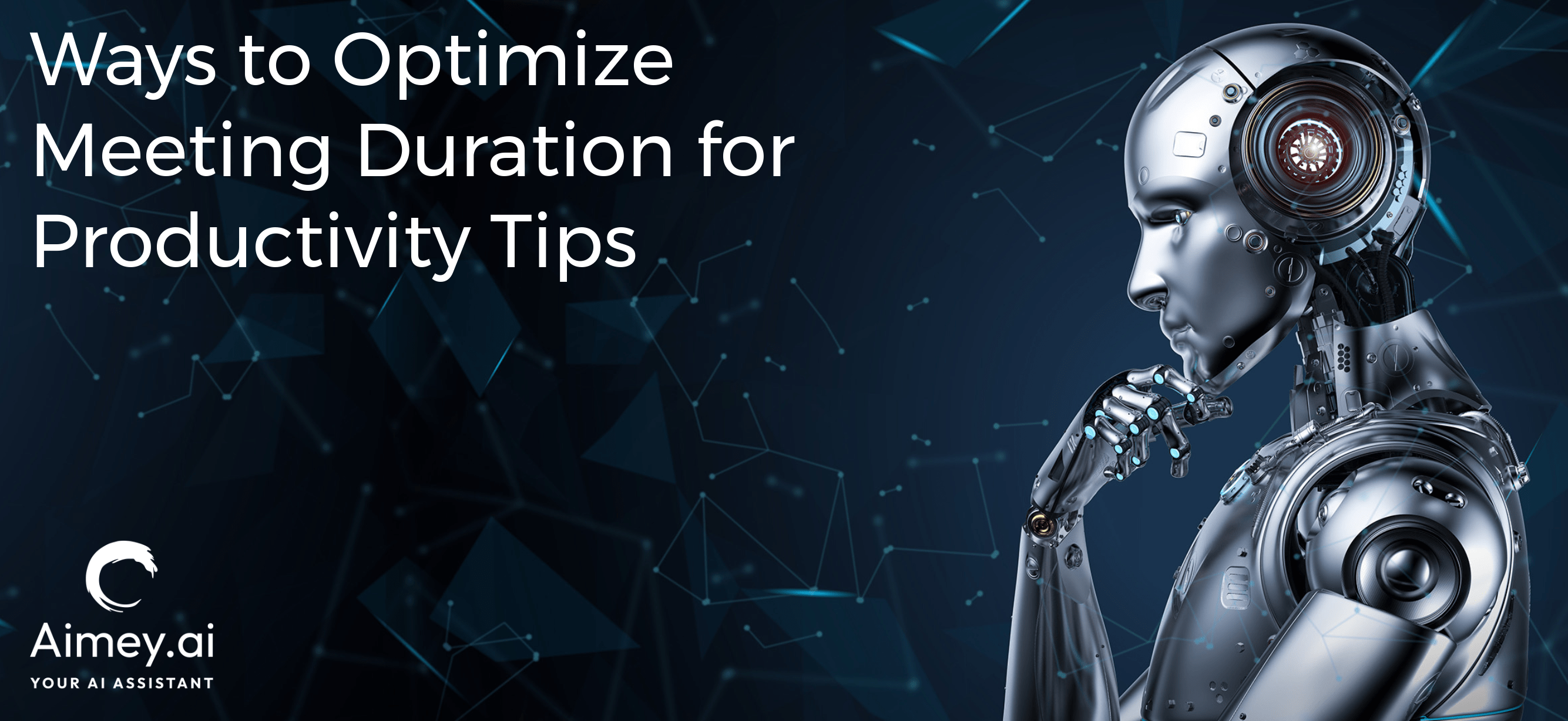Understanding the Importance of Efficient Meetings
Effective meetings are crucial for organizational productivity. Implementing ways to optimize meeting duration for productivity can transform your team’s workflow, making every interaction count. Whether we hold planning sessions, brainstorming discussions, or project updates, well-structured meetings ensure we achieve our objectives without wasting valuable time.
Identifying Common Time-Wasters in Meetings
Meetings often become inefficient due to several common pitfalls. Prolonged discussions on off-topic subjects, lack of clear objectives, and repetitive conversations can derail even the most well-intended gathering. By identifying and eliminating these time-wasters, we can create room for focused, meaningful conversations that drive actionable results.
Brief Overview of “Ways to Optimize Meeting Duration for Productivity”
The objective of perfecting meeting duration involves deliberate strategies and technology integration. Understanding the “ways to optimize meeting duration for productivity” equips us with the tools to streamline our meetings, ensuring each one is productive and concise. The next sections will delve into specific tactics and approaches to achieve this efficiency.
Prioritizing Agendas: The Key to Shorter, More Productive Meetings
Setting Clear Objectives
One of the most effective ways to optimize meeting duration for productivity is to start with a clear agenda. By setting well-defined objectives, we ensure that everyone knows the purpose of the meeting. Detailed agendas help in directing the discussion and keep the team focused. Additionally, sharing the agenda in advance allows participants to prepare adequately, leading to more meaningful contributions and less wasted time.
Eliminating Unnecessary Items
Not all topics need to be discussed in every meeting. Therefore, it’s crucial to eliminate non-essential items from the agenda. Assess each point and ask if it’s essential to discuss in the current meeting or if it can be handled through other communication channels like emails or a quick chat.
Utilizing Technology for Smarter, Quicker Discussions
Leveraging Collaborative Tools
Modern technology offers an array of collaborative tools designed to enhance communication and streamline discussions. For instance, using project management software or collaborative platforms can ensure that all necessary information is accessible to everyone before the meeting starts. This reduces the time spent on catching up and allows us to dive straight into productive conversations.
Integrating Video Conferencing
Remote work has made video conferencing platforms indispensable. These platforms not only save commuting time but also come with features like screen sharing, real-time document editing, and breakout rooms. Utilizing these features can help us stay on track and keep the meeting concise.
Adopting the ‘Ways to Optimize Meeting Duration for Productivity’ Approach
Structured Time Allocation
Structured time allocation is instrumental in keeping meetings focused. By setting a specific amount of time for each agenda item, we can prevent the discussion from going off-track. Timekeeping tools and designated meeting facilitators can further assist in ensuring adherence to the schedule.
Encouraging Active Participation
Active participation from all attendees fosters a more engaging and efficient meeting. We can encourage participation by asking specific individuals to lead different sections of the agenda. This distributes responsibility and keeps everyone involved, ensuring that all voices are heard and respected.
Post-Meeting Summaries
A concise post-meeting summary can serve as a useful tool for reinforcing decisions made and action items. Summaries should include key points discussed, decisions taken, and specific tasks assigned to individuals. This not only improves accountability but also reduces the need for follow-up meetings.
- Set Clear Objectives
- Eliminate Unnecessary Items
- Leverage Collaborative Tools
- Integrate Video Conferencing
- Structured Time Allocation
- Encourage Active Participation
- Provide Post-Meeting Summaries
Did you know? Instituting a strict agenda can reduce meeting times by up to 80%, significantly enhancing overall productivity in the workplace.
Leveraging Core Strategies to Enhance Meeting Efficiency
As we wrap up our discussion on optimizing meeting durations, it’s crucial to revisit the core strategies we’ve outlined. Prioritizing agendas stands at the forefront by ensuring every meeting has a clear, focused objective. This helps maintain structure and avoids unnecessary diversions, allowing us to utilize every minute effectively. Coupled with prioritizing our agenda, integrating technology smartly into our meeting workflow can greatly enhance communication efficiency, supporting swifter decision-making processes.
The Positive Impact of Shorter, Well-Structured Meetings on Overall Productivity
Transitioning to shorter, well-structured meetings can create a significant positive impact on overall productivity. By streamlining discussions and cutting out time-wasters, we can ensure more engagement and participation from all attendees. This not only boosts morale but also enhances the quality of decisions made, leading to more effective outcomes. Shorter meetings provide us with more time to focus on other critical tasks, enhancing personal productivity and overall organizational efficiency.
Implementing the ‘Ways to Optimize Meeting Duration for Productivity’
To achieve these benefits, implementing the “Ways to Optimize Meeting Duration for Productivity” is our next vital step. Tailoring these methods to fit our organizational needs can bring forth a transformative change. We recommend starting by applying techniques that show the quickest results, such as clear agenda setting and the use of collaborative tools like aimey.ai. Gradual, continuous improvements can lead to a cultural shift where efficient meetings become the norm.
FAQ
How can we effectively prioritize our meeting agendas?
To effectively prioritize meeting agendas, we start by clearly defining the purpose of each meeting. We identify the key objectives we want to achieve and list them in order of importance. By distributing the agenda in advance, attendees can come prepared, which supports a smoother and faster decision-making process. This organized approach helps optimize our time together, ensuring every item on the agenda receives the attention it requires. Transitioning smoothly between agenda items is crucial for maintaining momentum and engagement throughout the meeting.
What role does technology play in optimizing meeting durations?
Technology is pivotal in optimizing meeting durations. We leverage tools such as video conferencing, collaborative document platforms, and project management software to streamline communications. Such technological integrations contribute to more organized and interactive meetings, allowing real-time collaborations and quick access to necessary information. This helps in minimizing delays and ensuring that the meetings are concise and stay on track. Effectively utilizing these tools can shorten meeting times while enhancing productivity.
Can shorter meetings really improve overall productivity?
Absolutely. Shorter meetings encourage us to concentrate on the essentials, leading to quicker and more focused discussions. This creates an environment where every participant is more likely to remain engaged and contribute constructively. The time saved from shorter meetings can then be redirected towards other productive tasks. As a result, individuals and teams experience an upswing in productivity as they devote more time and energy to executing actions rather than discussing them extensively.
What are some initial steps we can take to optimize our meetings for productivity?
As a starting point, adopting clear agenda-setting practices and time management techniques is essential. This initial step will enhance meeting focus and efficiency. The inclusion of time limits for each agenda item and the appointment of a proficient meeting facilitator can greatly control the flow of discussion. Furthermore, seeking feedback after meetings and acting on suggestions provided can continuously improve the meeting process. Gradually introducing these tactics will drive progress in achieving adeptly optimized meetings.
How does Aimey.ai contribute to effective meeting management?
Aimey.ai plays an integral role in effective meeting management by providing tools that schedule, manage, and streamline meeting workflows. With AI-driven insights, aimey.ai helps us to determine the optimal duration for different types of meetings, ensuring that no time is wasted. It also aids in automating various preparatory tasks, such as creating agendas and summarizing meetings, further contributing to the reduction of unnecessary meeting durations. Embracing such solutions can lead to a significant uplift in meeting efficiency and overall productivity.

